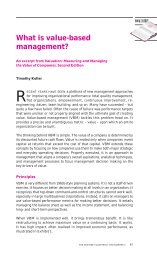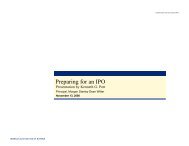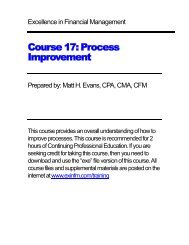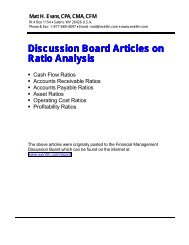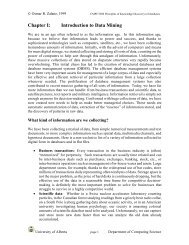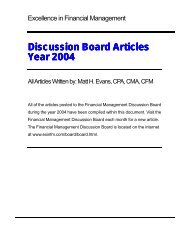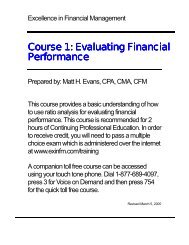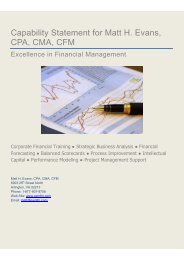Short Articles (PDF) - Excellence in Financial Management
Short Articles (PDF) - Excellence in Financial Management
Short Articles (PDF) - Excellence in Financial Management
You also want an ePaper? Increase the reach of your titles
YUMPU automatically turns print PDFs into web optimized ePapers that Google loves.
Your purchas<strong>in</strong>g practices should also consider a mixed approach. For example, why<br />
do you have to buy everyth<strong>in</strong>g new Purchas<strong>in</strong>g used items or rent<strong>in</strong>g can save a lot<br />
of cash flow. You may want to purchase <strong>in</strong> m<strong>in</strong>imum quantities, especially if your<br />
cash flow is tight. And do not hold <strong>in</strong>ventory that isn't mov<strong>in</strong>g - get rid of it!<br />
Other cash traps <strong>in</strong>clude <strong>in</strong>surance. Do not use <strong>in</strong>surance to cover all risks. Make<br />
sure you reta<strong>in</strong> some risks, especially if the risk is not materially significant and not<br />
likely to occur very often. One of the fastest ris<strong>in</strong>g <strong>in</strong>surance outflows is health care<br />
costs. Make sure you have a preventive program for your employees. This can<br />
<strong>in</strong>clude th<strong>in</strong>gs like annual cholesterol screen<strong>in</strong>gs, reimbursement for quit smok<strong>in</strong>g<br />
programs, and company participation <strong>in</strong> outdoor activities. F<strong>in</strong>ally, aggressively<br />
monitor your outstand<strong>in</strong>g receivables and beg<strong>in</strong> to take action at the first sign of<br />
trouble. If you have doubts about a customer's ability to pay, require an advance<br />
deposit.<br />
Cash Support for Sales Growth<br />
As sales grow, cash needs will grow. Plann<strong>in</strong>g for future sales must <strong>in</strong>clude plann<strong>in</strong>g<br />
for additional requirements for cash. A basic formula can be used to help determ<strong>in</strong>e<br />
the amount of additional cash needed for new sales. The formula is calculated as<br />
follows:<br />
Additional Cash = ((New Sales - Gross Profit) + Additional Overhead) / (Sales<br />
Growth Duration <strong>in</strong> Days x Average number of days to collect Receivables + Safety<br />
Factor)<br />
Example: We expect $ 10,000 of additional sales dur<strong>in</strong>g the year (365 days) with a<br />
correspond<strong>in</strong>g <strong>in</strong>crease of $ 3,000 <strong>in</strong> overhead. All payables are paid on time, we do<br />
not expect any changes <strong>in</strong> our collection periods, and we expect a cont<strong>in</strong>ued gross<br />
profit marg<strong>in</strong> of 25%. The average period to collect receivables is 40 days and we will<br />
add <strong>in</strong> a safety factor of 20% <strong>in</strong>to our estimate.<br />
($ 10,000 - $ 2,500) + $ 3,000 / 365 = $ 28.77 x (40 x 1.20) = $ 1,381 of additional<br />
cash is needed to support the $ 10,000 of additional sales.<br />
The above formula is a quick and rough estimate for estimat<strong>in</strong>g how much cash is<br />
needed to carry additional sales. Changes <strong>in</strong> collections and payment cycles need to<br />
be considered when us<strong>in</strong>g this formula.<br />
4



